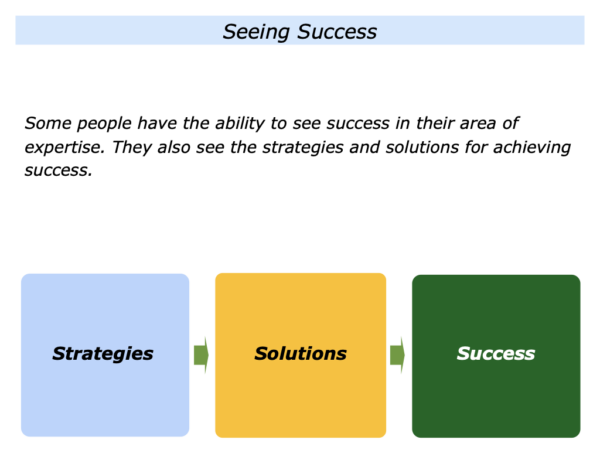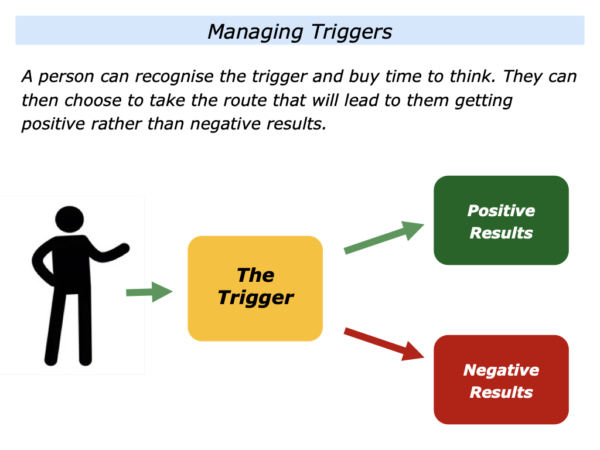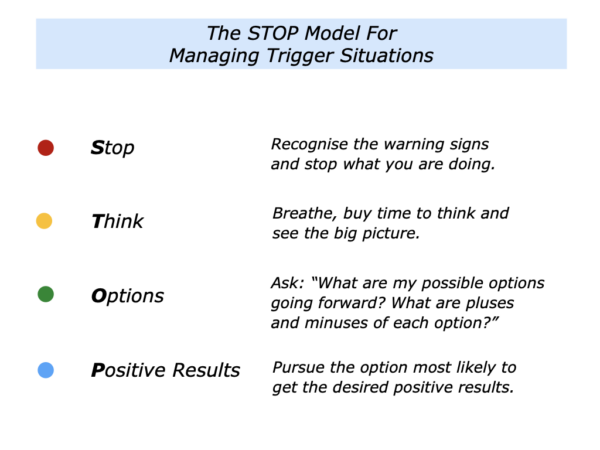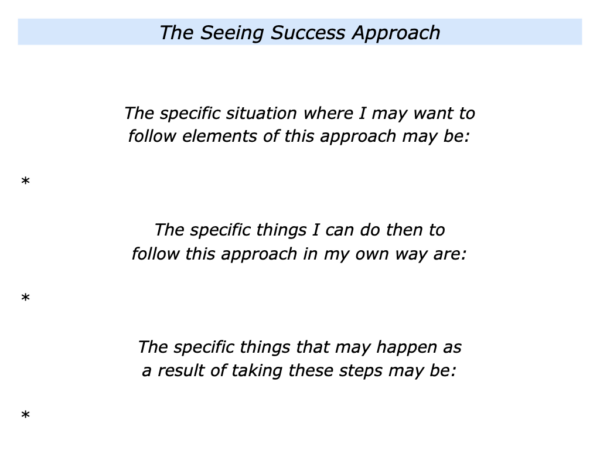
Some people have the ability to see success in their area of expertise. They also see the strategies and solutions for achieving success. They then apply their skills to do their best to achieve the picture of success.
Different people follow these principles in different activities. Let’s explore how they take these steps.
They See Success
Great workers go into situations where they excel and quickly see the picture of success. They may do this when encouraging a person, pursuing a specific activity or tackling a certain challenge.
Such people quickly gather information and clarify the possible destination. They go A, B … and leap to … Z. They clarify the real results to achieve and translate these into a clear picture of success.
Different people do this in different situations. Here is how some individuals describe pursuing their chosen activity.
“I focus on people’s strengths and can quickly see what a person can become … I love retail: so put me in any shop and I can quickly see how it can improve its sales … I am a garden designer and can quickly see how a garden can become a paradise.”
Matt Damon said something similar when playing the maths genius in Good Will Hunting. At one point his girlfriend asks him how he solves a problem. Will says that he cannot explain fully but that he simply sees the solution.
People who are visual see pictures but some may use other senses when clarifying the destination. Some individuals I have worked with expressed this in the following ways.
“I love sales and can literally smell a deal … I am a mediator: before a meeting I project myself to the feelings I would like people to have when they leave the room … I clarify the actual words I would like people to be saying after I have done a piece of work for them.”
Imagine that a person has taken this step and clarified the destination. They may then move on the next stage.
They See Strategies
For Achieving Success
Great workers explore the possible ways forward. Drawing on their experience of what works, they consider various scenarios for achieving the desired results.
Different people explore the potential strategies in different ways. Some people do this in a logical way. Bearing in mind the results to achieve, they may ask themselves the following questions.
“What are the possible options going forwards? What are the consequences – the pluses and minuses – of each option? What are the other potential creative solutions?
“What is the route I want to pursue? What are the key strategies I can follow to give myself the greatest chance of success? How can I translate these into a clear action plan?”
Great workers also sometimes use strategic intuition. Gary Klein studied people who took this approach. His books on the topic include Sources of Power: How People Make Decisions and The Power of Intuition.
Gary studied firefighters and other professionals who made decisions in pressure situations. The following section draws on an interview he gave to Bill Breen for The Fast Company magazine. He explained what he had learned in the following way.
“I noticed that when the most experienced commanders confronted a fire, the biggest question they had to deal with wasn’t ‘What do I do?’ It was ‘What’s going on?’
“That’s what their experience was buying them – the ability to size up a situation and to recognise the best course of action.”
Gary explained that firefighters saw the big picture and looked for patterns. They then began exploring potential strategies.
They reached into their experience – their hyperdrive – to scan previous scenarios and see what lessons might apply to the present situation;
They chose a potential course of action and played scenarios – like running a film in their heads – to see this might work in practice;
They ran the film to see if the strategy would work and, if so, they began pursuing it.
Imagine that a person has clarified the strategy – or combination of strategies – they want to follow. This may also sometimes involve focusing on the next theme.
They See Solutions
For Achieving Success
Great workers are good at finding solutions in the areas where they excel. They are also good at managing unexpected events. They then buy time to think and explore the possible solutions.
Gary Klein said that firefighters kept exploring various strategies until they found one that worked. They then visualised how to manage potential challenges. He explained this in the following way.
Once they make a decision, firefighters evaluate it by rapidly running a mental simulation. They might run through several choices, but they never compare one option with another.
They rapidly evaluate each choice on its own merits, even if they cycle through several possibilities. They imagine how a course of action may unfold and how it may ultimately play out.
They don’t need the best solution. They just need the one that works.
Different people explore how to find solutions in different situations. Recovering addicts and alcoholics, for example, rehearse how to manage triggers that could send them into a negative spiral.
Such people aim to avoid temptations and triggers. But they also rehearse how to manage such situations if, despite their best efforts, they encounter such events.
They aim: a) to recognise the trigger; b) to buy time to think; c) to sometimes use the STOP model for achieving positive results. This involves going through the following steps.


Imagine that a person has clarified their chosen strategy and the potential solutions to challenges. They may then move on to the next theme.
They Apply Their
Skills To Achieve Success
Great workers aim to perform superb work. Some have the ability to helicopter above the situation to see the whole picture whist also being able to be hands on.
Such workers often have a ritual for clicking into action. Being fully present, they then apply their professional skills:
To pursue their chosen strategies and deliver consistently high professional standards;
To embody continuous improvement by building on what is working and tackling areas for improvement;
To find solutions to challenges and do their best to achieve the picture of success.
Such workers then take time to reflect. Like professional golfers, they look back on their equivalent of hitting a shot. They then mentally rehearse how they could do it again to increase the chances of success.
Let’s return to your own work. Looking ahead, can you think of a situation where you may want to follow elements of the seeing success approach? How can you do this in your own way?
If you wish, try tackling the exercise on this theme. This invites you to complete the following sentences.







Leave a Reply